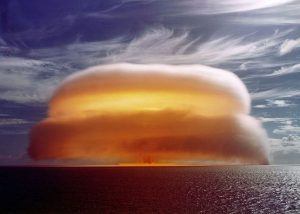Emiliano Rodriguez Mega in Nature:
 The world is as close to annihilation as it was last year, according to the Bulletin of the Atomic Scientists. The hands of the organization’s Doomsday Clock will stay at two minutes to midnight, it said, warning that the lack of progress on a host of global threats is a “new abnormal”. Stalled progress on addressing nuclear threats, lack of action on climate change and a worsening cybersecurity and cyberwarfare situation were of particular concern, the group said. This is the third time in the Bulletin’s history that the clock has been set so close to a global catastrophe, said Rachel Bronson, president and executive director of the organization, at a press conference in Washington DC on 24 January. The first came in 1953 at the height of the Cold War, when the Soviet Union and the United States were testing their thermonuclear bombs. Then, in 2018, the group adjusted the clock‘s hands after news of North Korea’s nuclear tests and increasing concerns over climate threats.
The world is as close to annihilation as it was last year, according to the Bulletin of the Atomic Scientists. The hands of the organization’s Doomsday Clock will stay at two minutes to midnight, it said, warning that the lack of progress on a host of global threats is a “new abnormal”. Stalled progress on addressing nuclear threats, lack of action on climate change and a worsening cybersecurity and cyberwarfare situation were of particular concern, the group said. This is the third time in the Bulletin’s history that the clock has been set so close to a global catastrophe, said Rachel Bronson, president and executive director of the organization, at a press conference in Washington DC on 24 January. The first came in 1953 at the height of the Cold War, when the Soviet Union and the United States were testing their thermonuclear bombs. Then, in 2018, the group adjusted the clock‘s hands after news of North Korea’s nuclear tests and increasing concerns over climate threats.
“The fact that the clock did not change is bad news indeed,” said Robert Rosner, an astrophysicist at the University of Chicago in Illinois and chair of the Bulletin’s Science and Security Board. “Where we are is very close to disaster.” In the last year, for example, cyberattacks aimed at corrupting the flow of information have polarized populations and undermined trust in science, said Herb Lin, a cyber security and policy researcher at Stanford University in California and a member of the Bulletin’s group on cyber and disruptive technologies.
“These practices attack the very idea of rational discourse,” said Lin. “It’s a more insidious use of cyber tools to exploit weaknesses in human cognition and thinking.”
More here.
